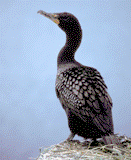United States Department of Agriculture, National Wildlife Research Center: Symposia

Symposium on Double-Crested Cormorants: Population Status and Management Issues in the Midwest
The Problems of Being Successful: Managing Interactions Between Humans and Double-Crested Cormorants
Date of this Version
December 1997
Abstract
The natural history, behavior, and ecology of double-crested cormorants (Phalacrocorax auritus) predispose this species for conflict with human sport and commercial fisheries. Cormorants breed early in life, have large broods, are efficient predators even in marginal conditions, seem to be able to adjust colony sizes quickly in response to local conditions, and have limited requirements for feeding and nesting habitats. A survey of the past history of successes and failures in managing cormorants reveals that economic impact is greatest with aquaculture and least in sport fisheries. Research during the past 5 years suggests that some control methods like culling and egg spraying are effective but must be balanced against the actual impacts on humans.

